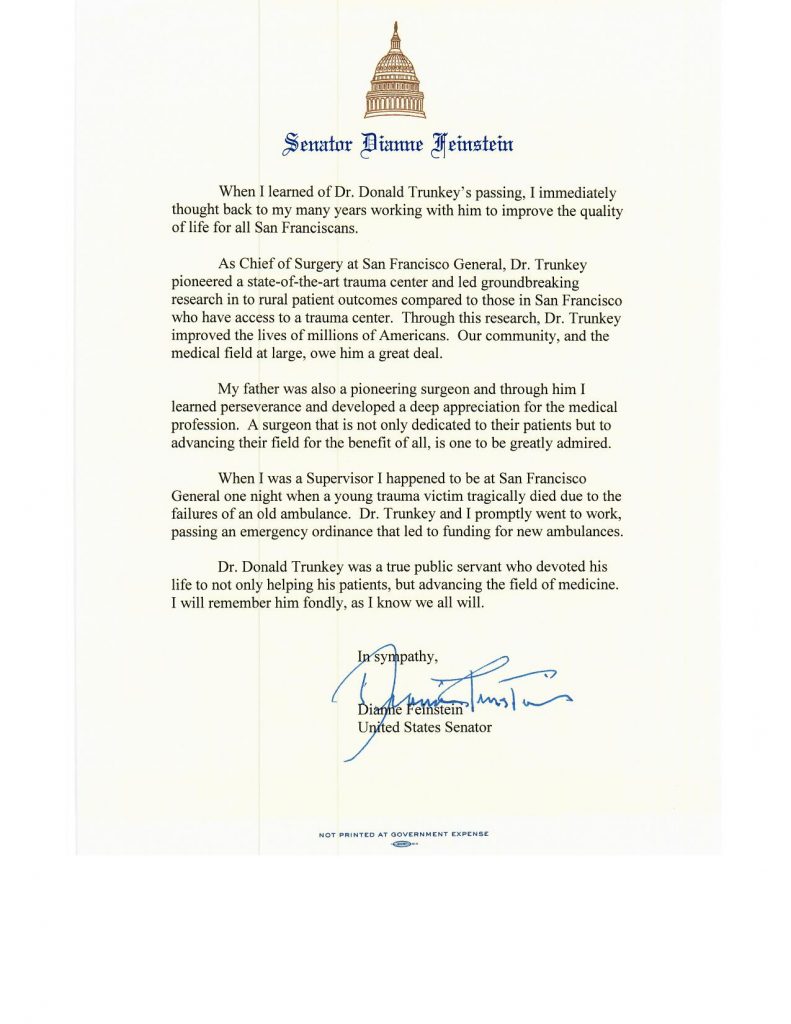Don Trunkey is being honored by the American College of Surgeons (ACS) this month at their annual Clinical Congress as an “Icon in Surgery”, an honor which he richly deserves. Don was the leader among a small cohort of surgeons who played a major role in improving the care of the injured not just in the U.S., but across the world, by advocating for the development of standards of care for trauma patients and defining what specific expertise, resources, and personnel needed to be in place for a hospital to provide optimal care to those patients.
After a rotating internship under Dr. J. Englebert Dunphy at the University of Oregon followed by two years in the U.S. Army in Germany, Dr. Trunkey travelled to the University of California, San Francisco (UCSF) to train in surgery, where Dr. Dunphy had assumed the chairmanship. He developed an interest in a career in trauma during his rotations at the San Francisco General Hospital (SFGH), which was then developing a reputation as a leader in the new specialty of trauma surgery under the direction of the skilled and charismatic chief of surgery, Dr. F. William Blaisdell.
Don heeded Dr. Blaisdell’s advice to study with Dr. Tom Shires at Parkland Hospital in Dallas, one of the most prestigious centers for both care of the injured and trauma research. At Parkland, Don learned research techniques for studying cellular mechanisms in shock and fluid resuscitation. He returned to San Francisco and joined the staff at SFGH, continuing his basic research under an NIH Program Project Grant in 1972, at the exact time that Federal recognition of Trauma Centers was beginning. SFGH was one of the first such centers recognized. At that time, however, most injured patients across the U.S. were taken to the nearest hospital for care, without regard for their preparedness to care for traumatic injuries.
The network of young surgeons who had trained at UCSF extended up and down the state of California, and among them was John West, a surgeon in private practice in Orange County who had completed the surgery residency at UCSF in 1973, just two years after Don. John was distressed at what he felt were unnecessary deaths from basic traumatic injuries such as splenic rupture due to delays in recognition and prompt treatment of their condition. He and Don co-authored a landmark study comparing mortality from equivalent injuries in community hospitals to that at SFGH, a well-equipped and well-staffed trauma center. The study demonstrated the superiority of the trauma center in saving lives.
Throughout the U.S. were hospitals such as SFGH that had also demonstrated their expertise in trauma care. Surgeons at these hospitals were the major members of the Committee on Trauma of the ACS, a committee that had been originally formed as the Committee on Fractures in 1922, but formally reorganized as the Committee on Trauma in 1950. At about this time, trauma was being recognized as a major public health issue, with increased highway accidents due to the development of higher speed automobiles and the interstate highway system as well as inner city violence from knife and gunshot wounds.
Don Trunkey had been appointed to the ACS Committee on Trauma where he served as its chair from 1982 – 1986, joining a small group of like-minded “rabble-rousers” to lobby the ACS for designating hospitals according to a system of standards of trauma care, described first in 1976 in a manual called Optimal Hospital Resources for the Injured Patient. It set standards for what resources, personnel, and policies a facility need to have to render ideal care and divided hospitals into Levels I, II, III, or IV based on minimum standards at each level. They also advocated for providers to be taught and tested in a rigorous course, the Advanced Trauma Life Support (ATLS) course, now in its 9th edition, but a hard-fought battle for acceptance in its earliest days. Don Trunkey was a key leader in development of all of the elements of effective trauma care. These now well-accepted principles, processes, and programs were not initially so readily embraced by the power structure in American surgery, because they represented radical new ideas in the staid, traditional field of surgery. They were, in a word, disruptive to the status quo.
Don went on to lead the American Association for the Surgery of Trauma as its President in 1986, disseminate trauma systems standards, verification, and ATLS teaching throughout the world.
He also served in the U.S. Army as a reservist since his days on active duty in the early 1960’s, and was deployed to Saudi Arabia during the first Gulf war in 1991, where he served as commander of the U.S. army hospital based in Riyadh. In the aftermath of that experience, he issued a white paper that suggested necessary changes in military combat care to improve outcomes. Again, this report was met with resistance by those in positions of authority, but all of his recommendations have subsequently been adopted : most specifically, for improved pre-combat training of military surgeons for combat and standardized protocols of care, with damage control care near the combat lines and air evacuation as soon as possible to progressively higher levels of care.
Don Trunkey was, more than any other single person, responsible for the development of sophisticated, state-of-the-art trauma programs in the U.S. His promotion of systematic, sound trauma care worldwide has saved countless lives. He has been tireless in his devotion to the cause and is a larger-than-life figure to all who know and love him. He is the perfect individual for the ACS to honor as an Icon in Surgery.
Karen Deveney, M.D., F.A.C.S.
The above remarks are drawn from both personal recollection as well as from the excellent account contained in the book, The History of the Surgical Service at San Francisco General Hospital authored by Drs. William Schecter, Robert Lim, George Sheldon, Norman Christensen, and F. William Blaisdell.


